A thin slice is cut out of a glass cylinder along a plane parallel to its axis. The slice is placed on a flat glass plate with the curved surface downwards. Monochromatic light is incident normally from the top. The observed interference fringes from the combination do not follow on of the following statements.
The fringes are straight and parallel to the length of the piece.
The line of contact of the cylindrical glass piece and the glass plate appears dark.
The fringe spacing increases as we go outwards .
The fringes are formed due to the interference of light rays reflected from the curved surface of the cylindrical piece and the top surface of the glass plate.
The correct Answer is:C
To solve the problem, we need to analyze the situation described and the statements given. Here’s a step-by-step breakdown of the solution:
Step 1: Understand the Setup
A thin slice is cut from a glass cylinder and placed on a flat glass plate with the curved surface down. Monochromatic light is incident normally from above. The light will reflect off the curved surface of the slice and the flat surface of the glass plate.
Hint: Visualize the arrangement of the glass slice and the plate. Consider how light interacts with both surfaces.
Step 2: Analyze the Interference
When light reflects off the two surfaces (the curved surface of the slice and the flat surface of the plate), it creates two rays. These rays will have a phase difference due to the different paths they take and the reflections.
Hint: Remember that reflection from a denser medium (glass) introduces a phase shift of π (180 degrees).
Step 3: Determine the Nature of Fringes
The interference of these two rays will create a pattern of dark and bright fringes. At the center of the slice, where the path difference is zero, we will observe a dark fringe due to the π phase shift.
Hint: Think about how the path difference changes as you move away from the center and how this affects the fringe pattern.
Step 4: Analyze Each Statement
1. Fringes are straight and parallel to the length of the piece: This is true as the interference pattern will be uniform across the length.
2. The line of contact appears dark: This is also true because the center has a dark fringe.
3. Fringe spacing increases as we go outwards: This is where we need to be careful. In this setup, the fringe spacing does not necessarily increase as you move outward; it remains constant due to the geometry of the arrangement.
4. Fringes are formed due to interference from the curved surface and the top surface: This statement is true as it describes the source of the interference.
Hint: Carefully evaluate each statement based on the principles of interference and the geometry of the setup.
Step 5: Identify the Incorrect Statement
From the analysis, the statement that fringe spacing increases as we go outwards is incorrect. Therefore, this is the statement that does not follow from the observations.
Final Answer: The observed interference fringes do not follow statement C: "The fringe spacing increases as we go outwards."
A thin slice is cut from a glass cylinder and placed on a flat glass plate with the curved surface down. Monochromatic light is incident normally from above. The light will reflect off the curved surface of the slice and the flat surface of the glass plate.
When light reflects off the two surfaces (the curved surface of the slice and the flat surface of the plate), it creates two rays. These rays will have a phase difference due to the different paths they take and the reflections.
The interference of these two rays will create a pattern of dark and bright fringes. At the center of the slice, where the path difference is zero, we will observe a dark fringe due to the π phase shift.
1. Fringes are straight and parallel to the length of the piece: This is true as the interference pattern will be uniform across the length.
2. The line of contact appears dark: This is also true because the center has a dark fringe.
3. Fringe spacing increases as we go outwards: This is where we need to be careful. In this setup, the fringe spacing does not necessarily increase as you move outward; it remains constant due to the geometry of the arrangement.
4. Fringes are formed due to interference from the curved surface and the top surface: This statement is true as it describes the source of the interference.
From the analysis, the statement that fringe spacing increases as we go outwards is incorrect. Therefore, this is the statement that does not follow from the observations.
Similar Questions
A thin slice is cut out of a glass cylinder along a plane parallel to its axis. The slice is placed on a flat glass plate as shown in Figure. The observed interference fringes from this combination shall be

View SolutionAssertion: A glass hemisphere is placed on a flat plate as shown. The observed interference fringes from this combination shall be circular.
Reason: In all cases fringes are circular.
View SolutionA block o plastic having a thin air cavity (whose thickenss is comparable to wavelength of light waves) is shown in fig. The thickness of air cavity (which can be considered as air wedge for interference pattern) is varying linearly from one end to other as shown.
A broad beam of monochromatic light is incident normally from the top of the plastic box. Some ligth lis reflected back above and below the cavity .The plastic layers than wavelength of incident light . An observer when looking down from top sees an interference pattern consisting of eight dark fringes and seven bright fringe along the wedge. Take wavelength of incident light in air as λ0 and refractive index of plastic as μ
Assume that the thickness of the ends of air cavity are such that formation of fringe takes place there.
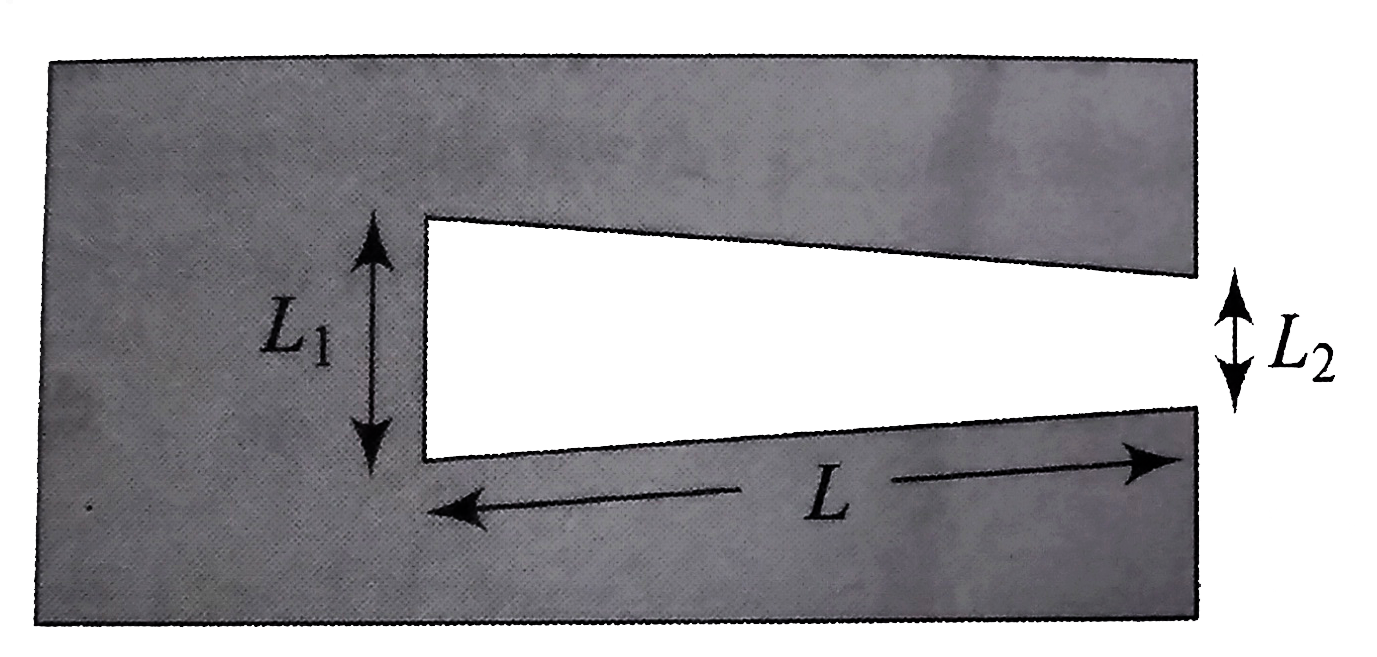
Determine the distance of 4th dark fringe from the left end of air cavity.
View SolutionA block o plastic having a thin air cavity (whose thickenss is comparable to wavelength of light waves) is shown in fig. The thickness of air cavity (which can be considered as air wedge for interference pattern) is varying linearly from one end to other as shown.
A broad beam of monochromatic light is incident normally from the top of the plastic box. Some ligth lis reflected back above and below the cavity .The plastic layers than wavelength of incident light . An observer when looking down from top sees an interference pattern consisting of eight dark fringes and seven bright fringe along the wedge. Take wavelength of incident light in air as λ0 and refractive index of plastic as μ
Assume that the thickness of the ends of air cavity are such that formation of fringe takes place there.
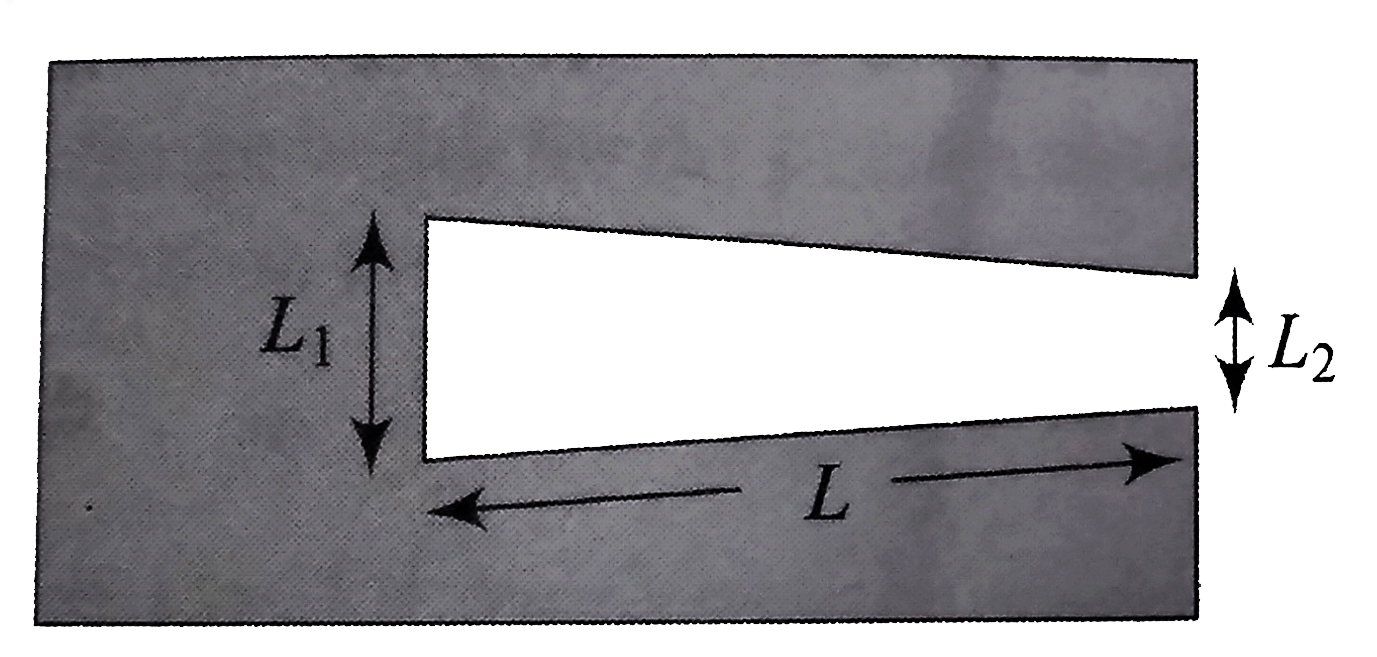
Determine the separation between 1st and 2nd dark fringes form the left end of air cavity
View SolutionA block o plastic having a thin air cavity (whose thickenss is comparable to wavelength of light waves) is shown in fig. The thickness of air cavity (which can be considered as air wedge for interference pattern) is varying linearly from one end to other as shown.
A broad beam of monochromatic light is incident normally from the top of the plastic box. Some ligth lis reflected back above and below the cavity .The plastic layers than wavelength of incident light . An observer when looking down from top sees an interference pattern consisting of eight dark fringes and seven bright fringe along the wedge. Take wavelength of incident light in air as λ0 and refractive index of plastic as μ
Assume that the thickness of the ends of air cavity are such that formation of fringe takes place there.
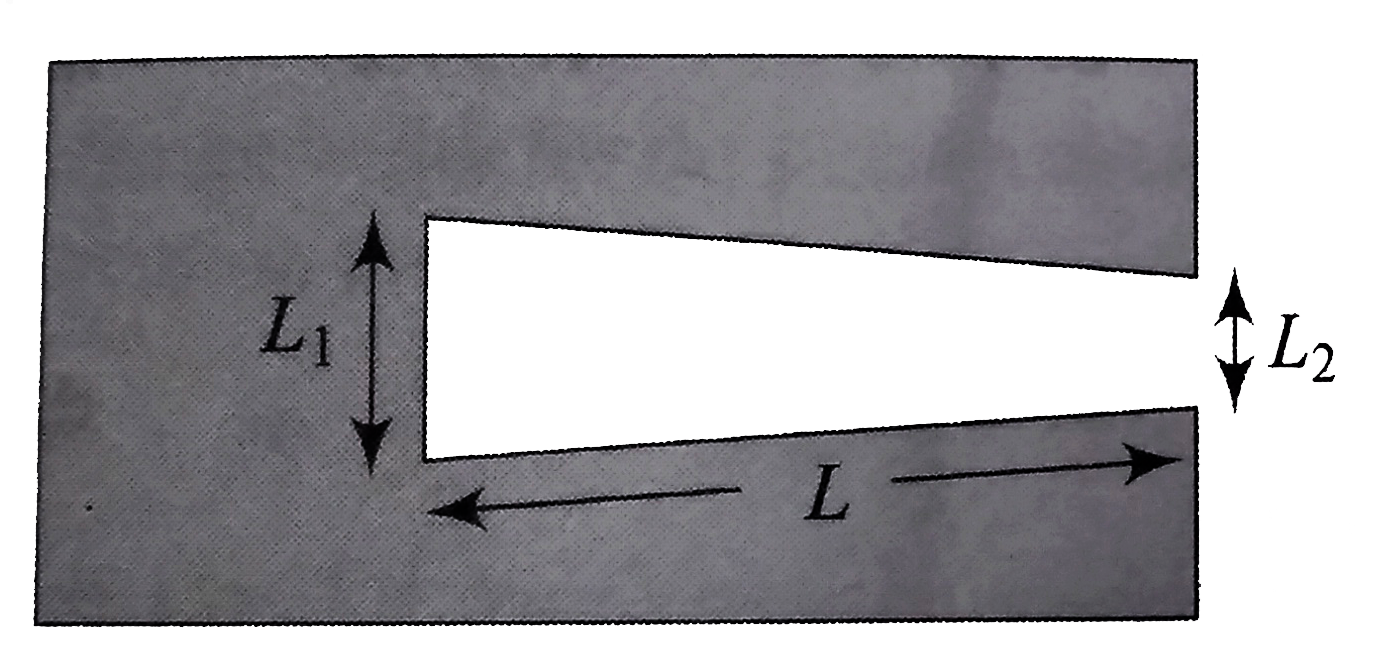
Determine of difference L1−L2=ΔL) in terms of λ0.
View SolutionA point sources S emitting light of wavelength 600nm is placed at a very small height h above the flat reflecting surface AB(see figure).The intensity of the reflected light is36% of the intensity.interference firnges are observed on a screen placed parallel to the reflecting surface a very large distance D from it.
(A)What is the shape of the interference fringes on the screen?

(B)Calculate the ratio of the minimum to the maximum to the maximum intensities in the interference fringes fromed near the point P (shown in the figure) (c) if the intenstities at point P corresponds to a maximum,calculate the minimum distance through which the reflecting surface AB should be shifted so that the intensity at P again becomes maximum.
View SolutionConsider an evacuated cylindrical chamber of height h having rigid conducting plates at the ends and an insulating curved surface as shown in the figure. A number of spherical balls made of a light weight and soft material and coated with a conducting material are placed on the bottom plate. The balls have a radius r<<h . Now, a high voltage source (HV) is connected across the conducting plates such that the bottom plate is at+V0 and the top plate at −V0 .
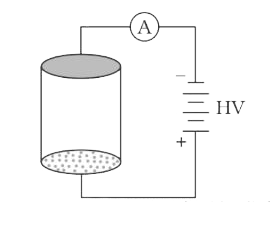
Due to their conducting surface, the balls will get charged, will become equipotential with the plate and are repelled by it. The balls will eventually collide with the top plate, where the coefficient of restitution can be taken to be zero due to be soft nature of the material of the balls. The electric field in the chamber can be considered to be that of a parallel plate capacitor. Assume that there are no collisions between the balls and the interaction between them is negligible. (Ignore gravity)
Which one of the following statements is correct ?
View SolutionAs shown, a narrow beam of light is incident onto a semi-circular glass cylinder of radius R. Light can exit the cylinder when the beam is at the centre. When the beam is moved parallel to a maximum distance d from the central line, no light can exit the cylinder from its lower surface. Find the refractive index of the glass.
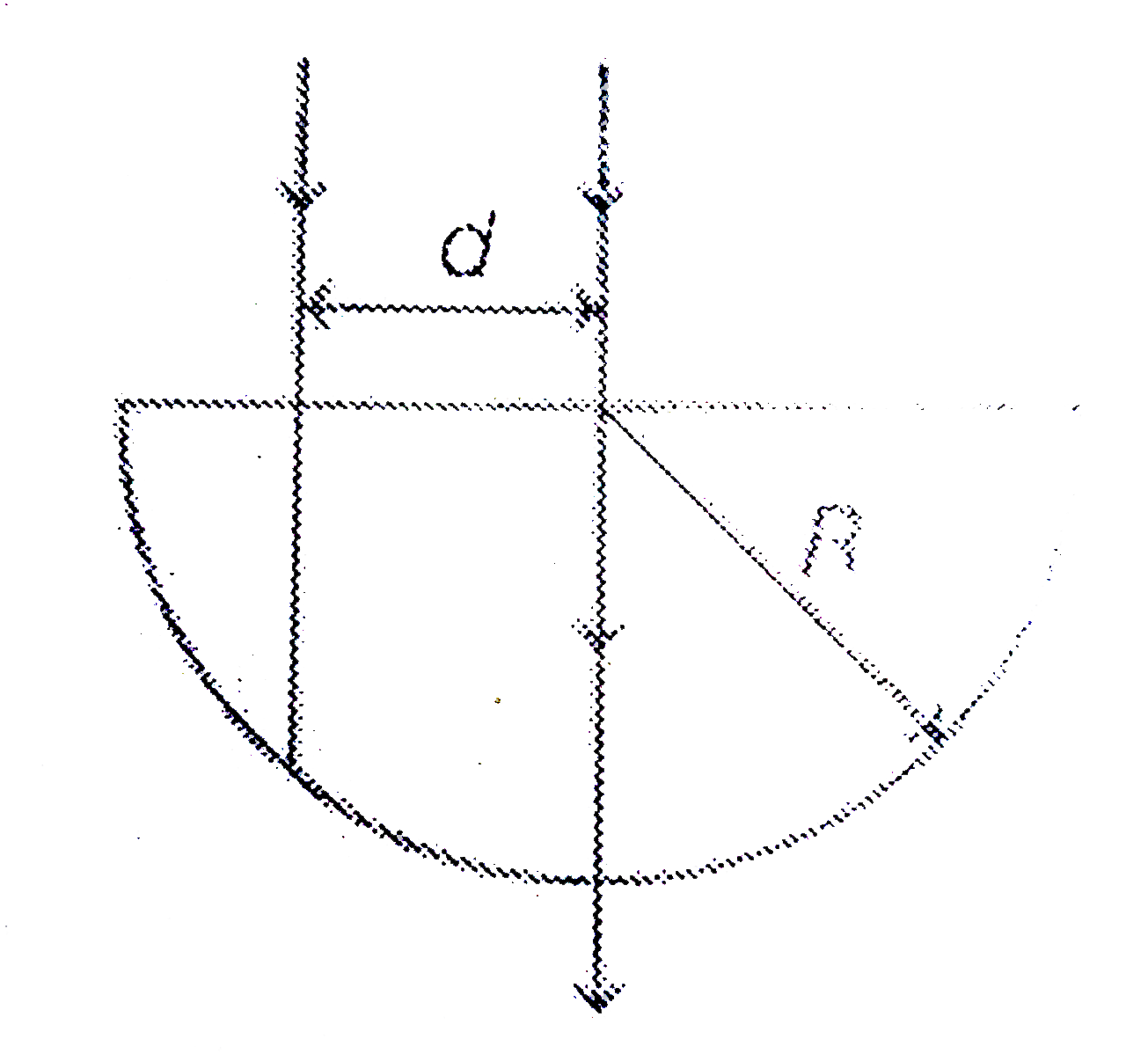
View SolutionA point source S emits light of wavelength 600 nm. It is palced at a very small distance from a flat reflecting mirror AB. Interface. Frignes as observed on the screen placed parallel to reflecting surface at very large distance D from it. The ratio of minimum to maximum intensities in the interference frignes formed near the point P is 1/6.
Q. What is the percentage intensity of the reflected light to the intensity of the reflectd light to the intensity of incident light?

View SolutionA point source S emits light of wavelength 600 nm. It is palced at a very small distance from a flat reflecting mirror AB. Interface. Frignes as observed on the screen placed parallel to reflecting surface at very large distance D from it. The ratio of minimum to maximum intensities in the interference frignes formed near the point P is 1/6.
Q. What is the shape of interference fringes on the screen?

View Solution
